I have two passions: Chess and Computer Science Education
Most of chess-player friends of mine are also IT experts; thus I have always asked myself whether these two subjects have something in common, and if the game of chess might in some way help develop computer skills.
But which skills should computer science students have?
Professor Bill Freeman* and Professor John Guttag** answer
Someone who enjoys solving problems, and who can think analytically, can do well at computer science…The study requires mathematical aptitude, but mostly an ability to organize and to think both creatively and logically.
These are the same requirements for a good chess player!
The game of chess contains the basic elements of structured programming: sequence, selection and iteration (for instance checkmate with rooks); the research based on artificial chess players is one of the main investigations on Artificial Intelligence. The relationship between mathematics and chess is widely recognized, and there are various pathways and methodologies that exploit the chess board to offer mathematical activities. But what about Computer Science children Education?
G. Kasparov vs Deep Blue (Source: AFP)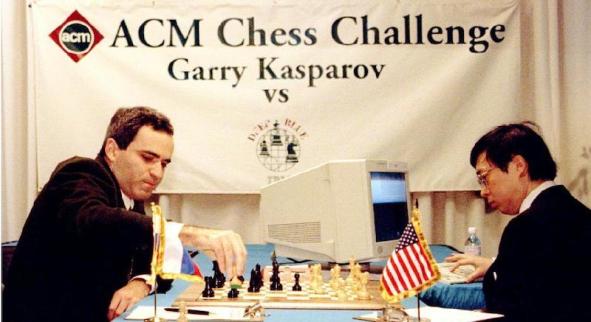
I submitted a proposal based on this idea to various universities, and finally last year Professor Laura Fedeli, teacher of “Play methodology and technique” at the University of Macerata, assigned a dissertation around this theme to brilliant student of Primary Education Science Barbara Falcioni (who already holds a degree in Cultural Heritage).
The dissertation concerned the development of algorithmic and computational thinking using psychomotor activities on a giant chessboard (PSG).
The PSG methodology has been used for several years at San Michele kindergarten in Fabriano (AN), starting with Mauro Gaspari, a chess player and computer scientist. The aim of the workshop is not teaching children how to play chess, but to let them approach the world of chess with the same curiosity they have when listening to a fairy tale, trying to enter it gradually, until they become part of it. A short description of the workshop structure can be found at: https://scacchi012.wordpress.com/2012/09/20/psychomotricity-on-giant-sized-chessboard-at-a-kindergarten/
The psychomotor practice is a fundamental element for a healthy development of the child, which is favoured by sense-motor play in which “the pleasure of acting enhances the pleasure of thinking”(B. Aucouturier). Furthermore, from last studies on neurosciences, it has been confirmed how psychomotor activity favours learning, speech development and abstract thinking, thus enhancing creativity and social abilities in children. In this kindergardenl setting, teacher Luana has been practising the Aucouturier method with success for several years. During the pathway the child’s cognitive, emotional and motor spheres are therefore satisfied (Hearth, Hand, Head, by Pestalozzi’s idea).
Various types of activities have been analysed by our research, as follows:
1) Square Perimeter Walk
(derived from csunplugged.org) The chessboard construction requires 64 squares to be arranged in a square perimeter, marked by four large black bands.
The chessboard construction requires 64 squares to be arranged in a square perimeter, marked by four large black bands.
In this activity children were asked to prompt simple commands (Forward/Stop/Turn) which a blind teacher had to follow, to walk along the perimeter of the square, in such a way as to avoid “falling”. The children were then asked to try the activity themselves.
2) Construction and “destruction” of the chessboard
It is believed that this activity is very important both for the cognitive development of the child, and for the social abilities involved. The children, working together, will have to find a strategy to build up the whole of the chessboard in a proper and orderly arrangement, proposing and argumenting their solutions. Children also experiment order and lack of order from the point of view of space, time and movement.
3) Construction of the king’s crown
 A recipe is a simple algorithm, so understanding a simple process as building a crown helps to develop algorithmic thinking: the input required (paper, scissors, scotch-tape..), how to process the input (processing) and what is the output (the crown). Therefore the children had to perform and share the necessary steps for the construction of the crown: folding, cutting, colouring, sticking and wearing.
A recipe is a simple algorithm, so understanding a simple process as building a crown helps to develop algorithmic thinking: the input required (paper, scissors, scotch-tape..), how to process the input (processing) and what is the output (the crown). Therefore the children had to perform and share the necessary steps for the construction of the crown: folding, cutting, colouring, sticking and wearing.
4) Capture simulation
Children are invited to collect objects or to hold a friend on the chessboard, in presence of obstacles (often other children), asking them to explain the direction needed FORWARD/OBLIQUE (diagonally), the number of squares (estimating) to walk on, and, if necessary to change direction (TURN), according to the character and the story they are interpreting (mainly King, Rook, Bishop). A request to identify a shorter path has been asked, also to collect objects in several moves (in previous experiences they were blocks of the same colour, letters, numbers, syllables, pieces of jigsaws to make up, association games), taking turns with another class mate (relationship with others).

5) Transformations
Use of a double-sided chessboard enabling both sides to be used. Children were asked to transform the chess board in a special pattern or interesting drawing, explaining aloud, rhythmically, their task (for example 1: White/White/Black) and adducing arguments for the repetitions present in case of controversies on the process to use to obtain the solution sought.We have also worked on smaller chessboards 5×5 (25 squares) to make other games that we envisaged as more suitable and significant for the small child. Strong importance given to storytelling when we have asked to transform the chessboard.
6) Graph Paper Programming
(derived from code.org)
6a) SYMBOL-ACTION SHARING
This activity, the most complex, includes a first moment of sharing commands (study of the symbol-action to be used), followed by a pathway for the White King who meets the Black King. In the pathway all chess characters gradually met, responding to the rhymes which were different every time and dramatised (the children enjoyed very much the activity with these strange characters).
The story has been perceived by children in a completely different way (two examples)
6b) SYMBOL-ACTION
In the second part of the activity commands were used to solve a riddle whereby it was asked to interpret a secret code revealing a mysterious character which was chasing the bishop “l’affannoso Alfiere” : the Rook
6C) ACTION-SYMBOL
In this last part we used an application to see how children succeeded in translating into symbols, autonomously and freely, the actions of a small bee who had to collect nectar from highly scented and very colourful flowers.
 We used the APP BeeBot^, chosen for the strong narrative component, for the graphic choice and the symbols used; this application did not, however, allow memorising the solution code, therefore it was necessary, when reaching a certain stage of complexity, to write down on paper the solution algorithm. This conclusive activity was very interesting, it enabled making numerous observations and it brought into action the different competences of the children, as well as the need by some of them to physically experiment movements (such as in activities 4 and 6.a).
We used the APP BeeBot^, chosen for the strong narrative component, for the graphic choice and the symbols used; this application did not, however, allow memorising the solution code, therefore it was necessary, when reaching a certain stage of complexity, to write down on paper the solution algorithm. This conclusive activity was very interesting, it enabled making numerous observations and it brought into action the different competences of the children, as well as the need by some of them to physically experiment movements (such as in activities 4 and 6.a).
Amongst the other App analysed, such as Kodable, KargoBot and so on, LighBot was interesting from the point of view of code writing, while narrative was absent and the graphics used was poor.
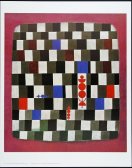
Paul Klee- Superchess (1931)
Some software, app, teaching children how to play chess satisfy these abilities, although we believe that in this age-group it is not at all necessary to exploit information technologies to teach children to think like a computer scientist (or a chess player), but priority should be given to psychomotor activities, as holistic approach developing willing, feeling and thinking. Other board games also develop these skills, such as the Go Game, but due to the strong symbolism of the game of chess and the archetypes of the pieces, chess is preferable to any other games.
Interesting resources
2012 CHESS AND MATHEMATICS: LEARNING BY PLAYING – Torino – Chess in School 28 May 2012 Conference Imparare il pensiero Computazionale di Michael Lodi (2013) L. Barzanti, S. Fabbri Gli scacchi come strumento per la didattica della matematica G.R.I.M., n.16 2006 12 games that teach kids to code — and are even fun, too Gatto Vittorio Graph Paper Programming by code.org Computer Science unplugged Psicomotricità in età prescolare by Sebastiano Paulesu Note *Associate Department Head of Electrical Engineering and Computer Science **Professor and former head of department at MIT ^BeeBot is a robot designed for teaching sequence, estimation and problem solving, now it is ready an APP version. http://www.bee-bot.us/
Filed under: psicomotricità, scacchi in età prescolare | Tagged: Computer Science, giant chessboard, psicomotricità, psychomotricity, scacchi e matematica, scacchi scolastici | 4 Comments »





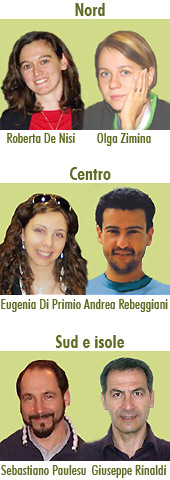

 Il silenzio all'inizio del primo turno. Di un torneo così. Le prime mosse, quando tutto è ancora possibile. Quando ancora tutti i sogni hanno diritto di cittadinanza. Quei primi minuti. In cui non si alza nessuno. In cui davvero tutti, tutta una sala, centinaia di persone, condividono gli stessi sentimenti.
Il silenzio all'inizio del primo turno. Di un torneo così. Le prime mosse, quando tutto è ancora possibile. Quando ancora tutti i sogni hanno diritto di cittadinanza. Quei primi minuti. In cui non si alza nessuno. In cui davvero tutti, tutta una sala, centinaia di persone, condividono gli stessi sentimenti.

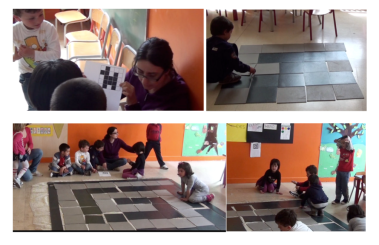
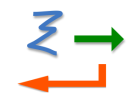




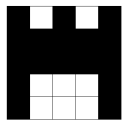


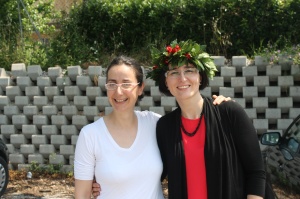
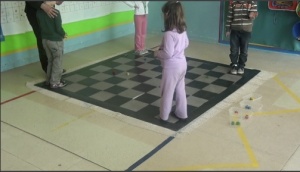












 La recensione dei libri della serie
La recensione dei libri della serie